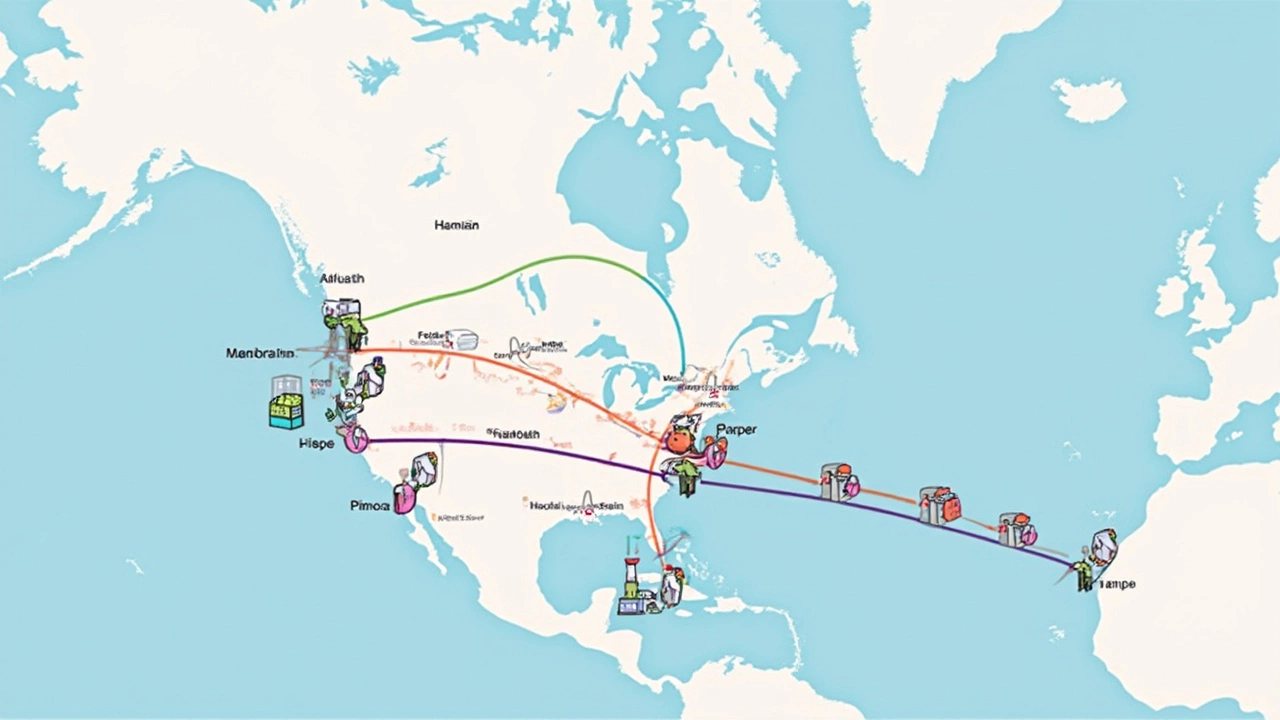So, you're thinking about jetting off to Canada to see a doctor? You're not alone. Lots of folks have the same idea, especially when trying to avoid hefty medical bills back home or waiting times that seem endless. But before you start packing, let's chat about what actually goes into seeing a doc in the land of maple syrup and hockey.
First off, Canada's healthcare system isn't quite the same as the US. It's publicly funded, which is why Canadians generally pay nothing for medically necessary hospital and doctor visits. However, this free access is for the citizens and permanent residents, which means, as an American, you'll need to pay out-of-pocket unless you’ve got some international health insurance.
Also, just because you're willing to pay doesn't guarantee you'll be seen. Doctors prioritize Canadian residents, and in some areas, getting an appointment can mean quite a wait. Sure, the care is top-notch, but access isn't always straightforward.
- Understanding Canada's Healthcare System
- Legal Aspects and Requirements
- Pros and Cons of Cross-Border Healthcare
- Cost and Insurance Considerations
- Practical Tips for Visiting Canada for Healthcare
Understanding Canada's Healthcare System
When folks talk about healthcare in Canada, they often mention it being 'free'. What's the deal with that? Well, the system is publicly funded and operates under a universal model. This means basic healthcare services are funded through taxes and available to everyone who's a citizen or permanent resident.
Now, each of Canada's provinces and territories has its own healthcare insurance plan. They all follow some federal guidelines, but there's variation in coverage and delivery. It’s not the same across the board and that can sometimes affect what’s available if you visit from the US.
The Role of Public Funding
Services typically covered by public funding include doctor visits, hospital stays, and most of the primary healthcare stuff. But it's important to note, this coverage doesn't extend to some scenarios – you won't find dental care or prescription drugs under the free umbrella. Many Canadians themselves get additional private insurance to cover these extras.
For Americans seeking medical services in Canada, this means any visits to doctors or specialists would likely incur charges, because they're outside the Canadian health plan’s reach. So, you might end up with a bill depending on what you need.
Popularity with Medical Tourists
Though Canada's system prioritizes residents, it’s still a destination for medical tourists. Why? For starters, its healthcare services are high-quality and, in many cases, more affordable compared to the US prices, even if you pay out-of-pocket.
Depending on where you go, some hospitals and clinics actually have facilities and staff ready to handle international patients. If you hit the right place, you might find yourself with some top-notch care minus the jaw-dropping bill.
| Province/Territory | Health Insurance Plan Name |
|---|---|
| Ontario | OHIP |
| British Columbia | MSP |
| Alberta | AHCIP |
Bottom line? Canada's healthcare system is comprehensive and well-regarded, but it's tailored for its residents. For cross-border healthcare, it's crucial for Americans to look into specifics, from potential costs to understanding which services are accessible. That way, your trip is smooth, and you don’t face surprises.
Legal Aspects and Requirements
Diving into the logistics of visiting Canada for healthcare requires some understanding of the legal side of things. It's not just a fly-by-night operation where you cross the border, pop in for a check-up, and head home. There are specific steps and legal considerations you need to be aware of before hopping into the cross-border healthcare lane.
Passport and Visa Requirements
First things first, you need a valid passport to enter Canada. If you're just going for a short-term medical visit, like most Americans, you won't need a visa. However, you should double-check if there are any changes to entry requirements close to your travel date. Staying informed about any temporary changes or health alerts can save you a lot of headaches at the border.
Medical Documentation
Bring all necessary medical documents, such as test results, imaging, and prescriptions. This will help Canadian doctors understand your medical history without starting from scratch. It's not mandatory, but it's a smart move to streamline your visit.
Legal Permission to Seek Medical Care
There's no formal legal restriction preventing Americans from seeking healthcare in Canada. But, availability isn't guaranteed. It's wise to contact the healthcare facility beforehand. They can tell you if the specific service you need can be provided and if they accommodate medical tourists.
Paying for Services
Unlike Canadian residents, you won't be covered by Canada’s public healthcare system. Be prepared to pay out-of-pocket unless your insurance company has an agreement with the Canadian provider. Prices can vary widely, so get a cost estimate in advance.
Healthcare Insurance
If you have international health insurance, confirm what expenses are covered before setting off. Some US insurance plans might offer partial coverage for procedures abroad, but details can be tricky.
Statistics on Wait Times
Here’s a little cheat-sheet on specialist wait times:
| Specialty | Average Wait Time in Days |
|---|---|
| Orthopedics | 80 |
| Cardiology | 25 |
| Dermatology | 30 |
The table gives a rough idea of potential delays, depending on the specialty. So, consider this when planning your visit.
Getting medical care across the border isn’t crazy complicated, but it does require some legwork. Keep these legalities in mind, and you’ll have a smoother journey towards achieving the care you need.

Pros and Cons of Cross-Border Healthcare
Thinking about heading north to see a doctor? Let's break down what that really means for you, from the positives to the potential hiccups.
Pros of Cross-Border Healthcare
- Cost Savings: Healthcare in Canada can be considerably cheaper than in the US. For some non-urgent procedures, the savings can be significant, especially if you're uninsured or underinsured.
- Quality of Care: Canada's medical professionals are highly qualified, and the care standards are rigorous. You’ll get good quality, safe healthcare services.
- Access to Specialists: In some cases, you might find quicker access to specialists for specific treatments, especially if you’re on a long waiting list back home.
Cons of Cross-Border Healthcare
- Waiting Times: While some services may offer quicker access, many non-urgent procedures and doctor appointments could still involve wait times, much like at home.
- Travel and Accommodation Costs: Savings on medical procedures might be offset by travel expenses and accommodation if you need to stay longer than planned.
- Insurance Coverage Complications: Make sure your insurance policy covers international treatments. If not, expect to pay out-of-pocket for the medical bills.
- Legal and Regulatory Differences: Healthcare operates under different regulatory frameworks, which can be confusing if you're not prepared for it.
Real Stories and Insights
In 2023, about 650,000 Americans traveled to other countries, including Canada, for various medical reasons. While many reported positive experiences, challenges like unexpected costs and paperwork were common themes.
Ultimately, it's about weighing these pros and cons, understanding your own health needs, and planning accordingly. The idea of cross-border healthcare seems convenient, but a little homework beforehand can go a long way!
Cost and Insurance Considerations
Navigating the financial side of getting medical care in Canada as an American can be tricky, but not impossible. The first thing to note is that the healthcare system in Canada might seem like a dream with its universal coverage for citizens, but for visitors, it's a pay-as-you-go model. Here's some straight talk on what to expect, cost-wise.
Paying for Your Healthcare
If you're heading north to see a doctor, you'll generally need to pay out-of-pocket at the point of service. This usually involves a trip to the cashier's desk right after your appointment. The cost can vary depending on the service, but here's a rough idea:
- Doctor’s visit: Anywhere from $100 to $300 CAD
- Specialist consultations: Around $300 to $600 CAD
- Diagnostic tests (like MRIs): Can be several hundred dollars or more
These numbers depend on the province and the specific facility, so it's a good idea to call ahead and get an estimate. Don’t forget the exchange rate either—it affects the total cost in your home currency.
Insurance: Friend or Foe?
Now, let's talk insurance. If you have travel health insurance with international coverage, it might cover some or all of your expenses in Canada. But before you count on this, double-check with your provider. You may need to pay upfront and then submit a claim for reimbursement.
If you travel frequently, look into long-term insurance plans that include international healthcare coverage. These can be a lifesaver for avoiding unexpected medical costs.
Additional Tips to Keep Costs Down
Finally, a few tips to avoid breaking the bank:
- Research facilities and costs ahead of time.
- Use the internet to evaluate and compare nearby clinics and hospitals.
- Ask about payment plans if the bill turns out higher than expected.
- Keep all paperwork for insurance claims.
Exploring your options beforehand can save not only your peace of mind but potentially a good chunk of change.

Practical Tips for Visiting Canada for Healthcare
Ready to make that trip? Let's break down some handy tips to make your healthcare journey to Canada smooth.
Do Your Homework on Providers
Before hopping the border, take some time to research Canadian healthcare providers. Look for clinics or hospitals that have experience with American doctor visits or handle international patients regularly. This ensures they're familiar with the paperwork and payment processes involved.
Check Your Insurance Coverage
If you've got any sort of international medical insurance or travel insurance, double-check what's covered. Some plans might include certain cross-border services, saving you a chunk of cash. If you're unsure, ring up your insurance provider and get the details.
Understand the Costs
While Canada's system is known for being affordable for residents, it's a different game for medical tourism. Be sure to get a cost estimate from the healthcare facility upfront. This helps avoid any surprise charges that might pop up after your visit.
Prepare Essential Documents
Keep all vital documents handy, like your passport, medical records, and insurance information. Having these within reach speeds up the process and ensures nothing gets lost in translation.
Consider Travel Logistics
Don’t forget about travel logistics. Think about your accommodation, transport, and how you'll get to the healthcare facility. Sometimes, facilities might offer a package deal that includes some of these, so it's worth asking.
| Item | Details |
|---|---|
| Insurance Verification | Ensure cross-border coverage |
| Personal ID | Passport and medical records |
| Cost Consideration | Request an estimate from providers |
With these steps in your toolkit, crossing over to access US Canada healthcare should be less of a mystery and more of an opportunity to get the care you need. Just keep these tips in mind, and you'll be set for a hassle-free experience!






